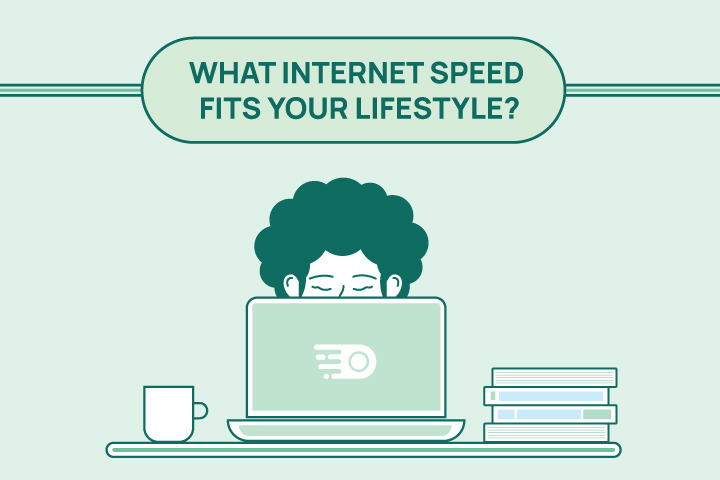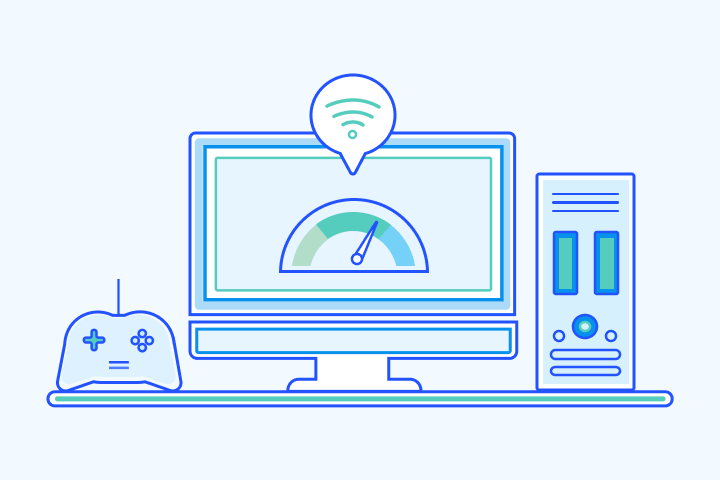What Internet Speed Fits Your Lifestyle?

HighSpeedOptions prides itself on providing honest, quality content. While we may be compensated when you make a purchase through links on our site, all opinions are our own. Here's how we make money.
Table of Contents
Choosing the right internet speed isn’t always simple. It depends on the number of people living in your household, how you use the internet, and the devices you rely on every day. Start by taking our 2-minute speed quiz or running an internet speed test to see how your current connection stacks up.
Need faster internet? We can help you find the best internet in your area at the best price.

How is internet speed measured?
Internet speed is measured in megabits per second (Mbps) and gigabits per second (Gbps).
According to the Federal Communications Commission (FCC), broadband internet has a download speed of at least 100 Mbps and a 20 Mbps upload speed.
- Download speed = how fast data transfers to your device (streaming, browsing).
- Upload speed = how fast data transfers from your device (video calls, file sharing).
- Synchronous speeds: upload and download are equal (common with fiber).
- Asynchronous speeds: download is faster than upload (common with cable and DSL).
Since most online activity downloads, advertised speeds usually highlight download numbers. But upload speeds matter too–especially for video calls, cloud storage, and online gaming.
Use the speed test below to see the speeds of your current internet connection.
How much speed do I need?
How much internet speed you need depends on how you and others in your household use the internet. Here are several questions to consider:
- How many people share your internet connection?
- Are multiple users streaming HD or 4K video at once?
- Do you spend hours gaming online?
- Are you studying or working from home?
- Do you have smart home devices (security cameras, thermostats, plugs)?
Internet Speed by Lifestyle
Here’s a quick guide to help match your household’s lifestyle to the right internet speed:
| Lifestyle Persona | Typical Activities | Recommended Speed |
| Light User (Single) | Email, browsing, social media, occasional SD video | 25-50 Mbps |
| Streamer (Single or Couple) | HD/4K streaming, music, video calls, occasional gaming | 100–200 Mbps |
| Remote Worker / Student | Frequent Zoom/Teams calls, cloud apps, file uploads, HD streaming | 200–300 Mbps (with at least 20 Mbps upload) |
| Gamer (Competitive) | Real-time online gaming, Discord, occasional streaming | 300+ Mbps with low latency and a wired connection |
| Smart Home Family (3–4 users) | Multiple 4K streams, online gaming, smart TVs, IoT devices (cameras, thermostats, security) | 400–500 Mbps |
| Large / Heavy Household (5+ users) | Several 4K streams at once, heavy gaming, frequent large file sharing, remote work | 500 Mbps–1 Gbps |
| Creator / Power User | Livestreaming, large uploads (YouTube, Twitch), professional video calls, multiple connected devices | 1 Gbps+ (high upload speeds recommended) |
| Lifestyle Persona | Light User (Single) |
| Typical Activities | Email, browsing, social media, occasional SD video |
| Recommended Speed | 25-50 Mbps |
| Lifestyle Persona | Streamer (Single or Couple) |
| Typical Activities | HD/4K streaming, music, video calls, occasional gaming |
| Recommended Speed | 100â200 Mbps |
| Lifestyle Persona | Remote Worker / Student |
| Typical Activities | Frequent Zoom/Teams calls, cloud apps, file uploads, HD streaming |
| Recommended Speed | 200â300 Mbps (with at least 20 Mbps upload) |
| Lifestyle Persona | Gamer (Competitive) |
| Typical Activities | Real-time online gaming, Discord, occasional streaming |
| Recommended Speed | 300+ Mbps with low latency and a wired connection |
| Lifestyle Persona | Smart Home Family (3â4 users) |
| Typical Activities | Multiple 4K streams, online gaming, smart TVs, IoT devices (cameras, thermostats, security) |
| Recommended Speed | 400â500 Mbps |
| Lifestyle Persona | Large / Heavy Household (5+ users) |
| Typical Activities | Several 4K streams at once, heavy gaming, frequent large file sharing, remote work |
| Recommended Speed | 500 Mbpsâ1 Gbps |
| Lifestyle Persona | Creator / Power User |
| Typical Activities | Livestreaming, large uploads (YouTube, Twitch), professional video calls, multiple connected devices |
| Recommended Speed | 1 Gbps+ (high upload speeds recommended) |
Other Factors That Shape Your Internet Lifestyle
Choosing a plan is about more than just speed. Consider these factors too:
Upload Speeds Matter
Most people focus on download speed, but upload speed powers video calls, cloud backups, gaming, and livestreaming.
- Light users: 1–3 Mbps upload
- Remote workers/students: 10–20 Mbps upload
- Creators/gamers: 50 Mbps+ upload (fiber ideal)
Latency & Reliability
A fast plan won’t feel fast if it’s unstable. Latency (ping) is important for gaming, video calls, and remote work. Look for providers with low latency and consistent uptime.
Future-Proofing Your Household
Needs grow over time—more devices, higher video resolution (4K → 8K), more smart tech. Choose a plan with a little extra headroom so you won’t outgrow it too quickly.
Take our 2 minute quiz to find the speed that’s right for you.
Find SpeedWhat to Know When Buying Internet
Provider ads show maximum speeds. Your real speeds may be lower due to Wi-Fi use, network congestion, or multiple devices. If speeds are much lower than expected, contact your provider—sometimes it’s an easy fix.
Wired vs. Wireless
You’ll only see full advertised speeds with a wired connection. Wi-Fi is convenient but slower, especially when many devices connect at once.
Types of Internet Connections
- Fiber: Fastest, most reliable, symmetrical speeds. Limited but expanding availability.
- Cable: Widely available, fast, but shared network can slow during peak times.
- DSL: Affordable, slower (max ~100 Mbps), speed drops with distance from provider.
- Satellite & Fixed Wireless: Useful for rural areas, but slower and weather-dependent.
Finding the Perfect Fit for Your Internet Lifestyle
The right internet speed depends on your online activities: how many people are online, how you use the internet, and what devices you rely on.
Start with your current speed test, compare it with the lifestyle chart above, and then choose a plan that gives you enough room to grow.
FAQs
Gigabit (1,000 Mbps) speeds can feel like overkill for one person, but are ideal for:
- Multi-user households
- Heavy streamers and gamers
- Content creators with frequent uploads
- Anyone wanting to future-proof as technology advances
It depends on your household size and how you use the internet. A single person who mostly browses and streams occasionally may only need 25–50 Mbps, while a family of four with multiple 4K streams, smart home devices, and gaming may need 500 Mbps or more. A good rule of thumb is to plan for at least 100 Mbps per person in your household.
Most online games need just 3–4 Mbps download and 1 Mbps upload. But for competitive gaming, latency matters more than speed. Gamers should aim for 300 Mbps or faster with a wired connection to minimize lag, especially if others in the home are streaming or working.
For smooth streaming, you’ll want:
- SD video: 3–4 Mbps
- HD video: 5–10 Mbps
- 4K Ultra HD: 25 Mbps+
If multiple devices are streaming at once, add these speeds together. Most households should plan for 100–200 Mbps to stream smoothly without buffering.
Netflix recommends 3 Mbps for SD, 5 Mbps for HD, and 25 Mbps for 4K. Multiply those speeds if multiple people stream at once. For two or more people regularly watching 4K content, plan for at least 100 Mbps.
In 2025, most experts consider 300 Mbps or faster a “fast internet speed.” Gigabit internet (1,000 Mbps) is best for large households, creators, and heavy gamers, but often more than a single user needs.
Remote workers should have at least 25 Mbps download and 3–5 Mbps upload for email, browsing, and occasional video calls. If you’re on video conferences daily, sharing large files, or using multiple cloud apps, aim for 100–300 Mbps with 20 Mbps upload or more. A wired connection and low latency will improve call quality.
For families, a good rule of thumb is 100 Mbps per person. A family of four that streams, games, and works from home may need 400–500 Mbps or more. Households with lots of smart home devices should consider 500 Mbps–1 Gbps to stay ahead of growing demand.
Smart home devices like cameras, thermostats, and smart plugs don’t use much bandwidth individually, but together they add up. Plan on 5–10 Mbps per device in addition to your household streaming, gaming, and work needs. Families with 10+ smart devices should consider 400 Mbps or more.
In 2025, most experts consider 300 Mbps or faster a good internet speed for the average household. This level supports multiple 4K streams, remote work, and smart devices at the same time. For larger households, heavy gamers, or content creators, 500 Mbps to 1 Gbps+ is ideal to ensure smooth performance and future-proof your connection.
The right speed depends on your household size and online habits. As a rule of thumb, plan for at least 100 Mbps per person. For example:
- Single user with light browsing: 25–50 Mbps
- Couples streaming and video calling: 100–200 Mbps
- Families with 3–4 people and smart home devices: 400–500 Mbps
- Large households or power users: 500 Mbps–1 Gbps+
Check what speeds are actually available in your area, since options vary by provider and connection type (fiber, cable, DSL, or satellite).
To see if faster internet is available near you:
- Run an internet speed test to compare your current speeds with recommended benchmarks.
- Use an availability tool by entering your ZIP code to see which providers and speeds are offered in your area.
- Compare plans side by side to find the fastest option at the best price.
Providers often upgrade networks over time, so even if gigabit or fiber wasn’t available last year, it may be offered in your neighborhood now.






